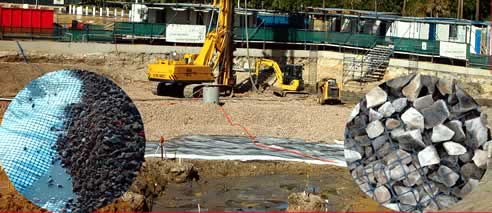Load transfer platforms from Polyfabrics Australia There is a long history and research that horizontals layers of rigid geogrids have been successfully used to reinforce the base of road structures and pavements built on soft soils with poor bearing capacity, reducing the pavement depth and differential settlement that may occur. The use of TerraGrid and Tenax LBO rigid geogrids provide the following benefits:
Certain building sites require access to heavy construction vehicle such as cranes and drill rigs. Their tracks can exert ground pressures in excess of 400kPa. The use of rigid geogrids such as TG3030 performs the same function as in the case of road pavement with he exception of the load is more concentrated. The granular fill is substituted with rock to suit the aperture of the grid (40mm to 60mm) without fines to start with. This forces the geogrid to lay flat. The more angular rock, the better the locking, the greater shear strength and bearing capacity. The geogrid layer is places at the interface of the low CBR sub-base layer and the platform. If this interface is below the water table, a filtration geotextile is placed first followed by the geogrid layer. The rock layer 200mm to 500mm is then placed uncompacted. The surface can then be blinded with the finer material and compacted or in the case this layer becomes the drainage blankets, a geotextile is used followed by a finer soil. Rigid geogrids behave differently to geotextile's (woven or non woven) even with similar or greater tensile strengths. Geotextile's transmit stresses to the soil through friction. They do not interlock with the aggregate the same was as a rigid geogrid with the thick apertures. For geotextile to provide reinforcement it must go into tension (Tension Membrane effect) and for this to occur it requires large deformation and fixed wheel paths. This is difficult to control and design, as a result the only function it achieves is separation. The transmission of stress between soil and geogrid is obtainable only if the geogrid is rigid and integral. A woven geogrid is constructed of high tensile polymer strands, can hardly develop this function, as the structure is not integral and the transversal ribs can move along the longitudinal ribs without developing any interlocking effect.
A properly chosen geogrid with angular rock is able to change the boundary conditions through three main
mechanisms:
|
Polyfabrics Australasia Pty Ltd Profile 02 9577 1800 200 Kingsgrove Road, Kingsgrove, NSW, 2208
|




